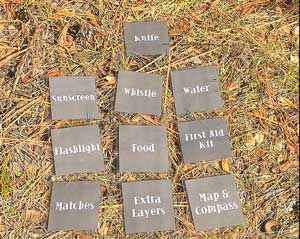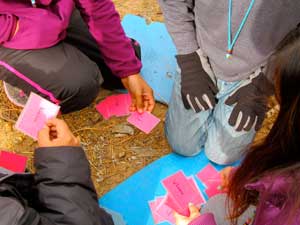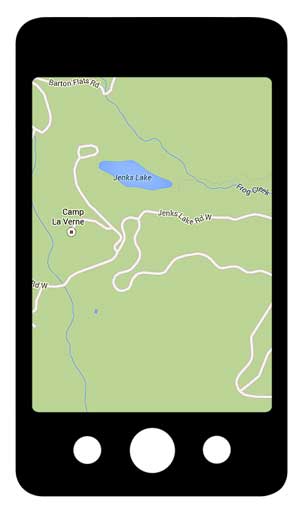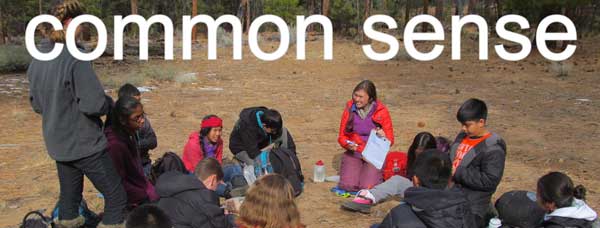When walking into an outdoor store like REI, I am often overwhelmed by the sheer amount of outdoor gear, equipment and clothing available to keep us safe and healthy in the outdoors. But what do we actually need?
 This question is integral during Outdoor Survival Hike, one of High Trails’ cornerstone classes, in which students learn about outdoor survival skills. In the most basic terms, humans require adequate supplies of food, water, air, and protection from the elements in order to survive each day. Typically, these needs are met by wearing proper clothing and making frequent visits to our faucets and pantries. However, it gets trickier when your home becomes the forest, a place in which the weather pays no mind to a thermostat and you must bring in your own supplies of food and water.
This question is integral during Outdoor Survival Hike, one of High Trails’ cornerstone classes, in which students learn about outdoor survival skills. In the most basic terms, humans require adequate supplies of food, water, air, and protection from the elements in order to survive each day. Typically, these needs are met by wearing proper clothing and making frequent visits to our faucets and pantries. However, it gets trickier when your home becomes the forest, a place in which the weather pays no mind to a thermostat and you must bring in your own supplies of food and water.
During Outdoor Survival Hike we split the class into small groups, giving each group a stack of fifteen cards that list various outdoor items that might prove useful on a day hike. Of these, High Trails has created a list of “Ten Essentials”: items that anyone venturing on a hike should always carry. On-duty instructors have each of these items in their backpacks while working.

Each group of students must consider the fifteen cards and eliminate five of them, thus creating their own list of essential items. Then, we rejoin as a large group and a representative of each group explains why his or her group elected to bring each item. Generally, the students agree on about eight of the ten items. Extra layers, food, water, map and compass, flashlight, matches, and a knife usually make each student’s cut. However, students tend to debate the necessity of having sun protection and a whistle, the final two items that High Trails deems essential. Instead, rope and a communications device (either a cell phone or a radio) often make it into students’ chosen essentials.
As an instructor, I love this activity because it provides students with the chance to showcase their knowledge of the outdoors by arguing why something could prove handy. Students see the versatility in rope and that it can have many uses, but I usually respond to their arguments that sun protection beats out a rope simply because of the rapidity with which the sun can damage our skin and eyes.
However, two arguments that occur week after week stem from our changing times and increased reliance on technology.
Whistle versus Cell Phone
 “But a whistle is only useful if there are people nearby to hear it,” one student voiced in a recent class, pinpointing the issue with relying on a whistle. The piercing cry of a whistle is universally recognized as a call for help and if there are people around, they will come to the rescue of the person in trouble. However, in many wilderness situations, there will not be people around due to the remoteness of the location. In fact, many hikers strive to find the most far-flung and isolated corners of the world for the very fact that they want to enjoy nature without the presence of other humans. In these cases, bringing a cell phone, satellite phone or SPOT device will serve the hiker much better in an emergency situation than a whistle would. However, as the students point out, oftentimes cell service won’t extend into these remote areas and the best bet is to go with a SPOT device or satellite phone.
“But a whistle is only useful if there are people nearby to hear it,” one student voiced in a recent class, pinpointing the issue with relying on a whistle. The piercing cry of a whistle is universally recognized as a call for help and if there are people around, they will come to the rescue of the person in trouble. However, in many wilderness situations, there will not be people around due to the remoteness of the location. In fact, many hikers strive to find the most far-flung and isolated corners of the world for the very fact that they want to enjoy nature without the presence of other humans. In these cases, bringing a cell phone, satellite phone or SPOT device will serve the hiker much better in an emergency situation than a whistle would. However, as the students point out, oftentimes cell service won’t extend into these remote areas and the best bet is to go with a SPOT device or satellite phone.
“But are there people around at High Trails?” I ask as the debate winds down. “Always,” the students respond, and it’s true. Each day groups set off with their instructor and wind their way around the network of trails meandering through the nearby National Forest. On any given day, I probably pass four to five other student groups. At High Trails, a whistle’s cry would be heard by many and thus deserves a place among the “Ten Essentials.”
Map and Compass versus GPS Device
 Although students rarely question the importance of bringing a map and compass, I like to ask them about it. “When your parents are lost while driving, do they usually whip out a map and try to find their location on it?” I’ve never had a student respond with a “yes” to this question and understandably so. In today’s day and age, road maps have become nearly obsolete as the ubiquitous smart phone enabled with Googlemaps gives us clear, concise directions at the moment we need them. Instead of remembering directions, our phones tell us exactly when to turn, when to merge lanes, and if our destination is located on the left or the right. It’s convenience at its best.
Although students rarely question the importance of bringing a map and compass, I like to ask them about it. “When your parents are lost while driving, do they usually whip out a map and try to find their location on it?” I’ve never had a student respond with a “yes” to this question and understandably so. In today’s day and age, road maps have become nearly obsolete as the ubiquitous smart phone enabled with Googlemaps gives us clear, concise directions at the moment we need them. Instead of remembering directions, our phones tell us exactly when to turn, when to merge lanes, and if our destination is located on the left or the right. It’s convenience at its best.
However, what about topographic maps that provide us with information on the local terrain and trails? “They’re important,” students usually say. But even topographic maps are sometimes beat out by GPS devices that can identify a hiker’s exact location without going through the complex process of triangulation or guesswork. “So why do hikers still rely on map and compass skills?” I ask my students. Their array of answers shows that they value learning how to read a map and that relying too much on technology can be risky. Their answers include: because GPS devices require batteries and outlets don’t exist in the outdoors; because it’s important to know how to do things the old-school way; and because GPS devices can be finicky or break and thus maps are more reliable.

The 11th Essential
 After students compile their list of Ten Essentials, we discuss the importance of planning a hike. “Plan Your Hike, Hike Your Plan” is a mantra we teach the students. Many of the tragedies that happen to people on outdoor adventures occur because of poor planning or neglecting to tell someone about the intended plan.
After students compile their list of Ten Essentials, we discuss the importance of planning a hike. “Plan Your Hike, Hike Your Plan” is a mantra we teach the students. Many of the tragedies that happen to people on outdoor adventures occur because of poor planning or neglecting to tell someone about the intended plan.
We emphasize to the students the importance of always telling someone of one’s intended destination and one’s estimated time of return. Doing so has saved lives in the past because then a search party knows where and when to look. The second part of the mantra is simple: stick to the original plan so that if anything should go awry, people will know where to start looking.
However, I like to remind students that by nature, the world of the outdoors is ruled by unpredictability and that weather can turn from sunny to stormy in a matter of minutes. Tunnel vision, the stubborn refusal of hikers to turn back when conditions become risky, has caused many of history’s outdoor rescues and fatalities. If a hiker finds himself or herself wondering, “Can I outrun this storm?” the answer should be “No.”

So to end this activity, I tell students to never forget the Eleventh Essential: common sense. Common sense allows hikers to decide when circumstances necessitate the use of a whistle over a communications device; a GPS device over a map and compass as well as prevents Tunnel Vision from placing hikers in dangerous situations. It is common sense that saves hikers’ lives.
At High Trails Outdoor Science School, we literally force our instructors to write about elementary outdoor education, teaching outside, learning outside, our dirty classroom (the forest…gosh), environmental science, outdoor science, and all other tree hugging student and kid loving things that keep us engaged, passionate, driven, loving our job, digging our life, and spreading the word to anyone whose attention we can hold for long enough to actually make it through reading this entire sentence. Whew…. www.dirtyclassroom.com

Comments are closed.